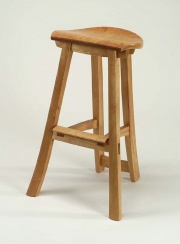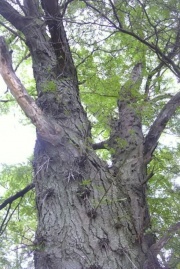Difference between revisions of "Honey locust"
m (Text replace - "== Authority ==" to "== Sources Checked for Data in Record ==") |
|||
| Line 2: | Line 2: | ||
== Description == | == Description == | ||
| − | A thorny tree, ''Gleditsia tricanthos | + | A thorny tree, ''Gleditsia tricanthos'' native to regions in North and South America, Africa, and Asia. The honey locust produces a high quality wood that polishes well and has been used occasionally for specialty furniture. The thorns were once used as nails. Currently, honey locusts are mainly grown as an ornamental tree as its slow growth minimizes their potential for commercial use. |
| + | |||
| + | Other locust tress in South America include a timber from the ''Hymenaea courbaril'' tree that is native to the tropical region of South and Central America. The dense orange-brown color wood from the South American locust tree is used in furniture, cabinetry, and shipbuilding. A natural resin, South American copal gum is also commercially produced from this tree. | ||
== Synonyms and Related Terms == | == Synonyms and Related Terms == | ||
| − | ''Gleditsia tricanthos''; févier épineux (Fr.); acacia de tres espinas (Esp.); espinheiro da Virgínia (Port.); honeylocust | + | 1) ''Gleditsia tricanthos''; févier épineux (Fr.); acacia de tres espinas (Esp.); espinheiro da Virgínia (Port.); honeylocust |
| − | |||
| − | |||
| − | '' | + | 2) ''Hymenaea courbaril''; jatobá (Port.); West Indian locust; Courbaril Plum; Locust Gum tree; South American locust |
| − | |||
| − | + | ==Physical and Chemical Properties== | |
| − | == | + | {| class="wikitable" |
| + | |- | ||
| + | ! scope="row"| Density | ||
| + | | 55-66 ppcf | ||
| + | |} | ||
| − | + | [[File:Honeylocustf5.jpg|thumb|Honey locust ''Gleditsia triacanthos'']] | |
| − | File:30_Honeylocust.jpg|Honeylocust (''Gelditsia triacanthos'') | + | [[File:30_Honeylocust.jpg|thumb|Honeylocust (''Gelditsia triacanthos'')]] |
| − | + | == Physical and Chemical Properties == | |
| + | Medium tree growning to 20-30 m Bark = gray brownn, smooth when young with clusters of thorns Leaves = alternate bipinnate Flowers = small hanging clusers Fruit = edible flat pods (15-20 cm long) with dark brown shiny seeds maturing in early fall | ||
| − | == | + | == Resources and Citations == |
| − | * ''Encyclopedia Britannica'', http://www.britannica.com Comment: "Honey Locust." | + | * ''Encyclopedia Britannica'', http://www.britannica.com Comment: "Honey Locust." Accessed: 21 May 2004 . |
| − | * | + | * Virginia Tech Dendrology website at www.fw.vt.edu/dendro/dendrology/main.htm (accessed Oct. 8, 2005) |
| − | * Wikipedia | + | * Wikipedia: http://en.wikipedia.org/wiki/Honey_locust (Accessed Oct. 8, 2005) |
[[Category:Materials database]] | [[Category:Materials database]] | ||
Revision as of 13:42, 3 October 2020
Description
A thorny tree, Gleditsia tricanthos native to regions in North and South America, Africa, and Asia. The honey locust produces a high quality wood that polishes well and has been used occasionally for specialty furniture. The thorns were once used as nails. Currently, honey locusts are mainly grown as an ornamental tree as its slow growth minimizes their potential for commercial use.
Other locust tress in South America include a timber from the Hymenaea courbaril tree that is native to the tropical region of South and Central America. The dense orange-brown color wood from the South American locust tree is used in furniture, cabinetry, and shipbuilding. A natural resin, South American copal gum is also commercially produced from this tree.
Synonyms and Related Terms
1) Gleditsia tricanthos; févier épineux (Fr.); acacia de tres espinas (Esp.); espinheiro da Virgínia (Port.); honeylocust
2) Hymenaea courbaril; jatobá (Port.); West Indian locust; Courbaril Plum; Locust Gum tree; South American locust
Physical and Chemical Properties
| Density | 55-66 ppcf |
|---|
Physical and Chemical Properties
Medium tree growning to 20-30 m Bark = gray brownn, smooth when young with clusters of thorns Leaves = alternate bipinnate Flowers = small hanging clusers Fruit = edible flat pods (15-20 cm long) with dark brown shiny seeds maturing in early fall
Resources and Citations
- Encyclopedia Britannica, http://www.britannica.com Comment: "Honey Locust." Accessed: 21 May 2004 .
- Virginia Tech Dendrology website at www.fw.vt.edu/dendro/dendrology/main.htm (accessed Oct. 8, 2005)
- Wikipedia: http://en.wikipedia.org/wiki/Honey_locust (Accessed Oct. 8, 2005)

